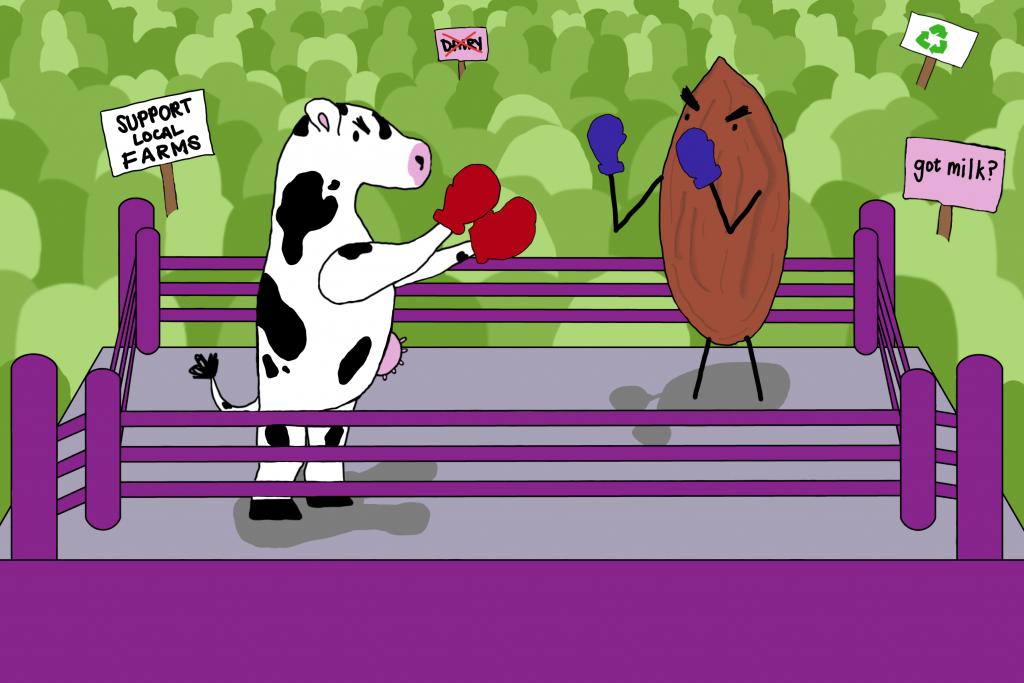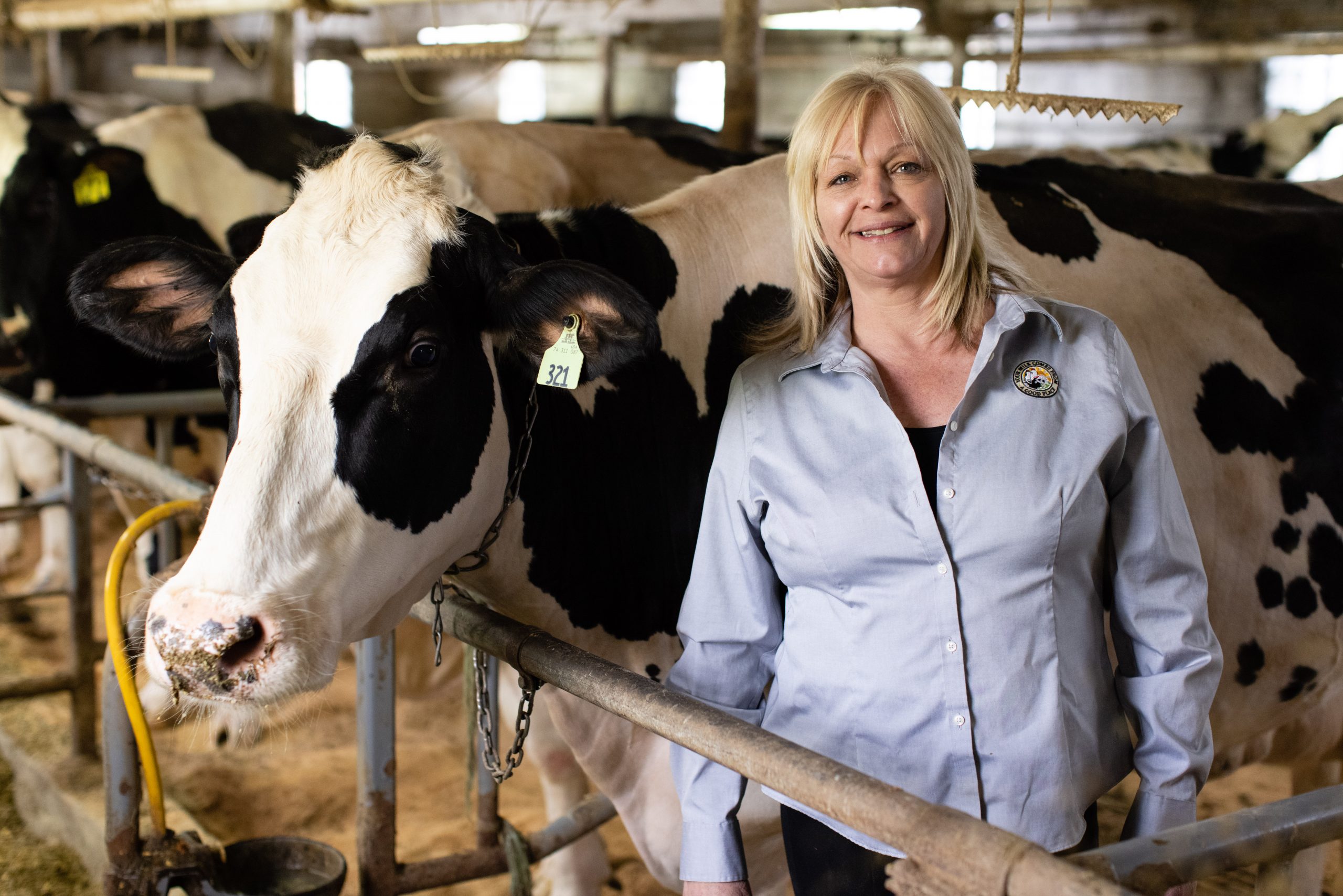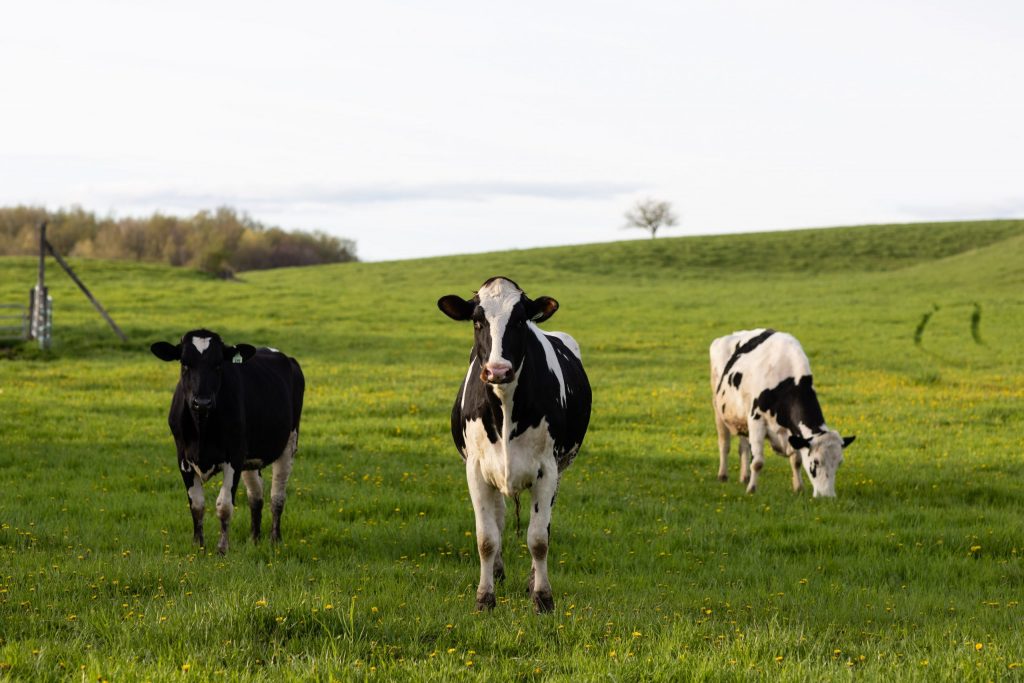The rise and fall of dairy milk
The rise and fall of dairy milk

“Do you know what the definition of milk is? It comes from an animal.”
That question and response have been at the heart of dairy farmers’ argument in recent years, as plant-based milk alternatives have taken the grocery aisle by storm. They have fought against the use of the term “milk” to describe dairy alternatives, trying to differentiate their product in a competitive market. Still, the plant-based milk industry increased sales from $2 billion to $2.6 billion from 2019 to 2021. Milk sales, while still valued at $14 billion annually, have been declining 2% to 2.5% every year. And it’s not just vegans driving this change. Plant-based beverages are the dominating animal-product alternative, beating out meat and cheese substitutes, meaning some non-vegan households are also choosing these products in addition to or instead of traditional dairy milk.
While almond milk still accounts for the majority of plant-based beverage purchases, oat milk is rising in popularity. Mary-Kate Smitherman, senior director of communications for Oatly, said oat milk accounts for 21% of the alternative dairy market in the U.S. Because the company is only 5 years old, she’s optimistic about the future.
“[Oat milk] continues to grow fast, all while the cow’s dairy segment shrinks,” Smitherman said. “The opportunity ahead is massive.”
Dairy milk has been a staple in American culture — or at least we’ve been led to believe it is. During World War I, the government created a large demand for milk, specifically powdered and canned milk, to be sent to soldiers overseas. After the war, dairy farmers were left with a surplus of milk, and by 1919, the government started milk campaigns that pushed dairy as a necessary part of our diets. Ideas of the serene countryside and hardworking, honest farmers further advertised milk as a wholesome beverage.
The “Got Milk?” campaign, started by the California Milk Processor Board in 1993 in response to declining milk sales driven by more soft drink consumption, had a budget as large as national pharmaceutical and automotive brands. The iconic milk mustache donned the faces of celebrities and athletes on billboards and in commercials.
Though milk provides important nutrients, such as calcium, vitamin D and protein, dairy isn’t as essential to our diets as these federally funded campaigns taught us. Emily Riddle, a registered dietician with a private practice in Ithaca, said it’s possible to get the nutrients in milk from other sources, even plant-based ones.
“There certainly are many vitamins and minerals and nutrients that are found in dairy products,” Riddle said. “But there are now, especially with the explosion of plant-based products, a lot of plant-based alternatives that are darn similar and both fortified with vitamins and minerals in a way that it largely mimics what you would find naturally in dairy products.”
Today, among Gen Z and some Millennials, the nutrient benefits of milk aren’t driving consumption. It’s “cringey” to drink dairy milk. Oat and almond milk are part of young adults’ personalities, inspiring Tweets, merch and Starbucks drinks.
we as a society need to make oat milk as the default milk
— do not perceive me (@mitosismoses) May 4, 2022
Still, the trend is about more than T-shirt slogans and iced lattes. Riddle said that concern about climate change seems to be driving this shift.
“I see a lot of people moving — at least in my practice — more plant-based for environmental sustainability,” Riddle said. “And as I watch people do that, then of course, dairy is one of those things to go. So, I do see that a lot more in maybe Millennials and younger than I do in older adults.”
The rise of plant-based milk is not without consequences. Family-owned dairy farms were already struggling to compete with larger corporate farms. The growing milk alternative industry creates further pressure. Audrey Donahoe, a fifth-generation dairy farmer and board president of the American Dairy Association North East (ADANE), a promotional organization representing dairy farmers in New York, Pennsylvania, New Jersey, Delaware and Maryland, said the farmers she works with are wary of dairy alternatives.
“[Plant-based milk companies] put a ton of money into advertising, and it bothers me to see that. My farmers get very upset when they see it,” Donahoe said. “Well, and I get upset too, and I completely understand that because they feel as though it’s going to be stealing away from us in the market and that we’re not going to have the fluid milk sales that we need.”
Donahoe explained that there are different classes of dairy products, and the lower classes turn less of a profit. Fluid milk is class one, meaning it turns the highest profit, while other dairy products are ranked in class two, three or four. So, while the consumption of butter, cheese and yogurt isn’t necessarily affected by almond milk sales, farmers’ primary source of income is. ADANE is currently trying to market to people who have stopped purchasing milk because they prefer the taste of the plant-based options.

“It’s not so much that they dumped dairy and dairy products, but they like the flavor of something else,” Donahoe said. “So, you know, what can we do about that? Well, we’ve got to work on this innovation: different flavors and offerings in the varieties that we’re looking for.”
While farmers try to compete, large companies are thriving at their expense. Michelle Tynan, a food studies graduate student at Syracuse University who has worked extensively in the dairy industry, said that corporate consolidation blurs the line between plant-based companies and dairy companies. Danone owns both Horizon Organic and Silk. Coca-Cola owns Fairlife and AdeS, a plant-based milk company. Not only do these monopolies affect consumer choice, they also push out small dairy farmers.
“[Big corporations] are basically playing both sides and saying like, ‘Well, either way, we’re good.’ It does have quite an impact on dairy farms,” Tynan said. “These big corporations bought these companies and got bigger, so they could sell milk really cheaply to consumers, which meant that farmers were getting less money for their milk unless they got really, really big. That requires a lot of loans and expanding barns, expanding infrastructure, and already a lot of them are aging out.”
To avoid being forced out of the industry, Donahoe said ADANE is trying to target Gen Z. Virtual farm tours, cooking classes and Instagram infographics make up the majority of their marketing, moving away from the “Got Milk?” era of advertisement.

“Our biggest discussion right now is stemming around Gen Z. How can we target different generations, and how do we relate to them?” Donahoe said. “So we’ve been doing a lot of work in the social media arena. Our biggest goal is to gain their trust. They’re consuming now, but they’re our future consumers as well.”
While dairy farmers try to maintain their base, plant-based milk companies are focusing on growth, all while upholding their claims of sustainability.
“We market to everyone. The greatest impact we can have as a company is to convert dairy users into Oatly consumers, empowering the plant-based revolution,” Smitherman said. “In general, plant-based milks, like oat milk, are less taxing on the planet than cow’s milk. However, we know that as we grow, certain aspects of our corporate footprint will increase and that’s why we strive to be as responsible as we can, as we reach more people.”
But, Tynan emphasized that there is no one sustainable beverage. While many consumers lean toward plant-based alternatives for the environment, both dairy and plant-based milk have positive and negative impacts. Soy production drives deforestation, almonds require gallons of water to grow and plant-based kinds of milk are shipped around the world. Dairy cows require water and land and emit methane gas, but the milk you buy from your local grocery store is supporting a farm near you.
“I don’t think plant-based milks are a golden ticket to being environmentally friendly. There’s just a lot of gray areas,” Tynan said. “There’s no one solution, but if we could all be focused on reducing the impacts of climate change and becoming more sustainable, I think that is the best outcome.”








